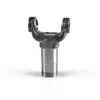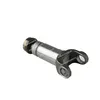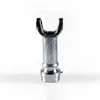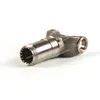A Slip yoke is a crucial drivetrain component used primarily in vehicles with a two-piece driveshaft. It allows the driveshaft to change length as the suspension moves up and down, maintaining a consistent connection between the transmission and the differential. This flexibility prevents binding and ensures smooth power transfer, reducing wear on other driveline parts. Typically made from high-strength steel or aluminum, Slip yokes are designed to handle high torque and rotational forces, making them essential for both performance and off-road applications.
Our Slip yokes are engineered to meet rigorous standards, ensuring durability and optimal performance. Below are the detailed specifications presented in lists and a table for clarity.
| Parameter | Value Range | Application |
|---|---|---|
| Spline Count | 10 to 36 splines | Adapts to various transmission outputs |
| Outside Diameter | 1.5 inches to 3.5 inches | Fits standard and custom driveshafts |
| Length Adjustment | ±1 inch to ±3 inches | Accommodates suspension travel |
| Torque Capacity | Up to 1000 lb-ft | Suited for high-performance and heavy-duty use |
| Operating Temperature | -40°F to 250°F (-40°C to 121°C) | Stable under extreme conditions |
What is the primary function of a slip yoke?
The primary function is to allow the driveshaft to change length dynamically as the vehicle's suspension articulates, ensuring uninterrupted power transfer from the transmission to the differential without causing binding or vibration.
How do I know if my slip yoke needs replacement?
Signs include unusual vibrations during acceleration, clunking noises when shifting gears, visible wear or corrosion on the splines, and fluid leaks from the transmission output seal. Regular inspection during maintenance is recommended.
Can I use any slip yoke with my driveshaft?
No, compatibility depends on spline count, diameter, and length. Always match the yoke to your transmission model and driveshaft specifications to avoid driveline issues. Consult our product guide or a professional for assistance.
What maintenance does a slip yoke require?
Lubrication is key. For unsealed yokes, apply high-quality grease to the splines periodically. Sealed units may require less frequent maintenance. Inspect for wear and damage during routine service intervals.
Are there performance benefits to upgrading my slip yoke?
Yes, upgrading to a high-strength yoke can improve durability, reduce driveline slack, and enhance torque handling, which is beneficial for modified, high-horsepower, or off-road vehicles.
How do I install a slip yoke correctly?
Ensure the transmission is supported, remove the old yoke, clean the output shaft, apply appropriate lubrication to the new yoke's splines, and slide it into place until seated. Torque any retaining hardware to manufacturer specifications and check for proper alignment.







